What makes the Filipino spirit so strong in the face of adversity? The Philippines, hit by 20 typhoons a year, shows incredible resilience. Despite disasters like super typhoon Egay in 2023, many Filipinos kept going, showing their strength.
According to resilience is a key trait of Filipinos. They adapt and thrive in tough times, thanks to their culture and values. This resilience has grown from the country’s history of struggles.
Key Takeaways
- The Filipino spirit is characterized by its ability to overcome challenges with strength and resilience.
- The Philippines faces numerous challenges, including natural disasters and poverty, yet the Filipino people consistently demonstrate their ability to recover and adapt.
- Resilience is a key factor in the country’s ability to cope with adversity, with many Filipinos showing their strength in the face of challenges.
- The country’s history and culture have contributed to the development of this resilience, which is deeply rooted in Filipino values.
- The Filipino people’s ability to persevere and thrive in challenging situations is a testament to their strength and resilience.
- Understanding the Filipino spirit of resilience is essential to appreciating the country’s ability to overcome adversity and build a stronger future.
Defining Resilience in the Filipino Context
Resilience is key to beating challenges and growing stronger when faced with tough times. In the Philippines, this trait is deeply rooted in the culture and mindset. Filipinos have dealt with many challenges, like natural disasters and economic struggles. Yet, they always manage to bounce back stronger.
A study on National Resilience in Filipino adults showed that community spirit and political views play big roles. It also confirmed the Filipino adapted National Resilience Scale (NRS-Filipino). This means Filipinos have a special way of handling resilience, shaped by their culture and history.
Despite all the challenges, Filipinos stay hopeful about the future. They are among the happiest countries, as shown by the Gallup International survey. Their resilience is a powerful reminder of the human spirit’s strength, inspiring others to stay hopeful.
The following table summarizes some key statistics on Filipino resilience:
| Category | Statistic |
|---|---|
| Happiest countries in the world | 3rd (Gallup International survey) |
| Overseas Filipino Workers (OFWs) | 2.3 million (Philippine Statistics Authority, 2019) |
| Female OFWs | 55.8% of total OFW population (Philippine Statistics Authority, 2019) |
The Role of Community in Building Resilience
Community is key in building resilience. It offers a support system that helps people get through tough times. The “bayanihan” spirit, or communal unity, boosts productivity and motivation in the Filipino community. It helps foster strength and perseverance among its members.
Social connectedness is vital for a resilient community. It helps communities deal with and bounce back from disasters and other challenges. Some ways to build resilience include:
- Improving social connectedness
- Increasing government integration and involvement
- Ensuring effective risk communication
- Bolstering physical and mental health
- Building social and economic health of the community
By using these strategies, communities can grow stronger and more resilient. As climate change affects more people, building community resilience is more critical than ever.
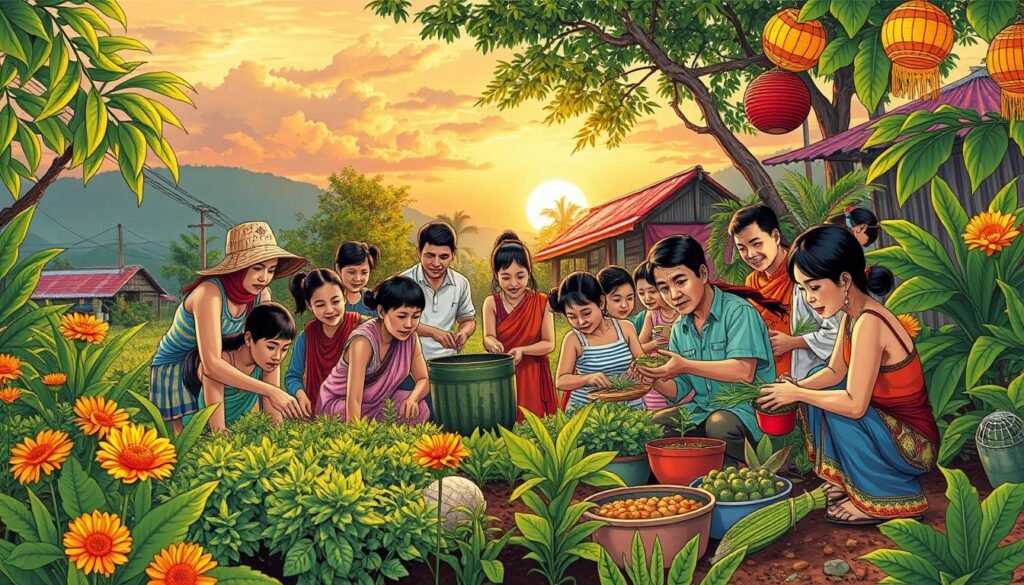
By supporting each other, communities can face and conquer challenges. This fosters a stronger, more persevering community.
| Strategy | Benefits |
|---|---|
| Improving social connectedness | Enhanced community cohesion, better response to disasters |
| Increasing government integration and involvement | More effective risk communication, improved disaster response |
| Ensuring effective risk communication | Better informed communities, improved decision-making |
Resilience in Filipino History
The Philippines has faced many challenges, like colonialism and natural disasters. Yet, the Filipino people have always found a way to adapt and keep going. This shows them hope for a brighter future.
Take Super Typhoon Haiyan in 2013, for instance. It caused huge damage and loss of life. But the Filipinos came together to rebuild, showing their strength in the face of challenges.
Triumphs Over Colonialism
The Philippines has fought hard to be free from colonial rule. It gained independence from Spain and then the United States. This struggle has made the Filipino people strong and resilient.
The Aftermath of Natural Disasters
The Philippines has also dealt with many natural disasters. Typhoons, earthquakes, and volcanic eruptions have tested its people. But Filipinos have always found a way to bounce back, supporting each other in hard times.
For example, after Typhoon Haiyan, families were able to start over. They did this with help from their communities and the government. This experience has given them hope for a better tomorrow and taught them the value of resilience.
Personal Stories of Resilience
Many people show resilience by facing challenges head-on. Teresa Magbanua, known as the “Visayan Joan of Arc,” is a great example. She showed strength and perseverance during the Philippine Revolution against Spanish rule. Her story, shared on sinaunangpanahon.com, shows how she went from a schoolteacher to a respected military leader. She broke societal norms and defied expectations of women’s roles at the time.
Other public figures have also shown resilience. Some have overcome big health challenges, like ulcerative colitis, and led successful lives. One person, who wants to stay anonymous, lost 25.32% of their body weight but made a big comeback. Their story shows the human spirit’s power to persevere against all odds.
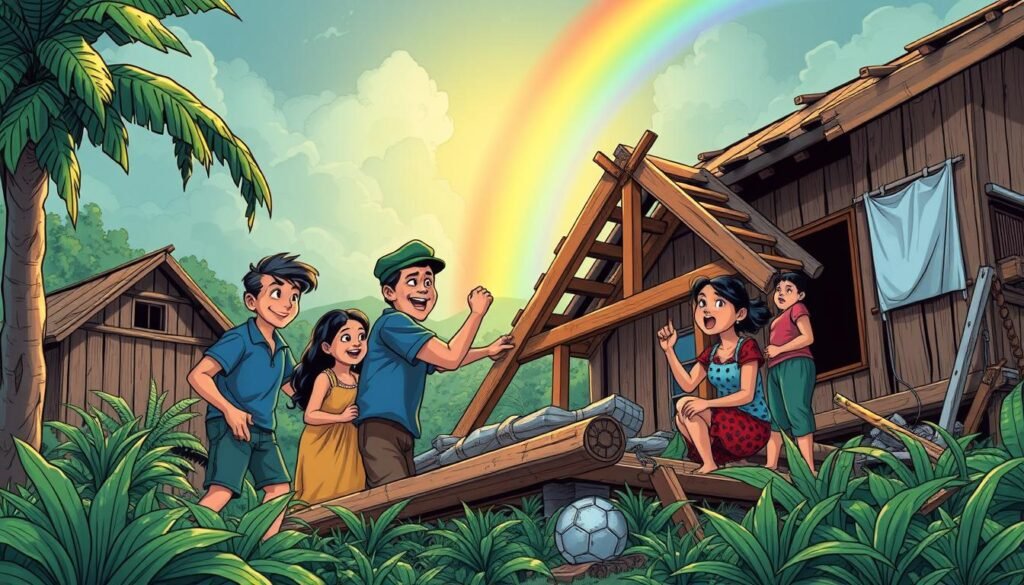
Everyday Heroes: Ordinary Filipinos Who Inspire
There are also many ordinary Filipinos who inspire with their strength and perseverance. These people, though not famous, have made a big difference in their communities. Their stories remind us that resilience can be in anyone, no matter their background or situation.
The Impact of Education on Resilience
Education is key in building resilience, facing challenges head-on. It gives students the skills and knowledge to succeed. This helps them feel hopeful and confident in overcoming obstacles.
Research shows that students in educational programs that focus on resilience do better academically. They also show more positive behaviors.
Several factors help build resilience in education. These include access to resources, support from teachers and peers, and opportunities for extracurricular activities. Schools that offer these can help students develop coping skills and achieve their goals.
A study on Filipino students showed that support and resources lead to resilience and success.
Here are ways education promotes resilience:
- Providing students with opportunities for extracurricular activities
- Offering support from teachers and peers
- Encouraging students to develop problem-solving skills

By using these strategies, schools can help students face challenges with hope. They can achieve their goals and look forward to a better future.
| Factor | Contribution to Resilience |
|---|---|
| Access to resources | Provides students with the tools they need to succeed |
| Support from teachers and peers | Helps students develop a sense of belonging and confidence |
| Opportunities for extracurricular activities | Allows students to develop new skills and interests |
Resilience in the Face of Natural Disasters
Preparing for and responding to natural disasters needs strength and perseverance. The Philippines, hit by typhoons, earthquakes, and floods, shows the Filipino people’s ability to recover. They always bounce back.
The International Monetary Fund says natural disasters have grown over 30 years. This shows we must prepare and respond well. The Sendai Framework from 2015 aims to lessen disaster risks and losses.
Building resilience involves several steps:
- Regular risk assessments and emergency plans
- Early warning systems and evacuation plans
- Training on disaster risk reduction
- Strengthening community bonds
A study on Filipino communities hit by disasters found strong community resources help. It used scales like the Connor-Davidson Resilience Scale to measure resilience.
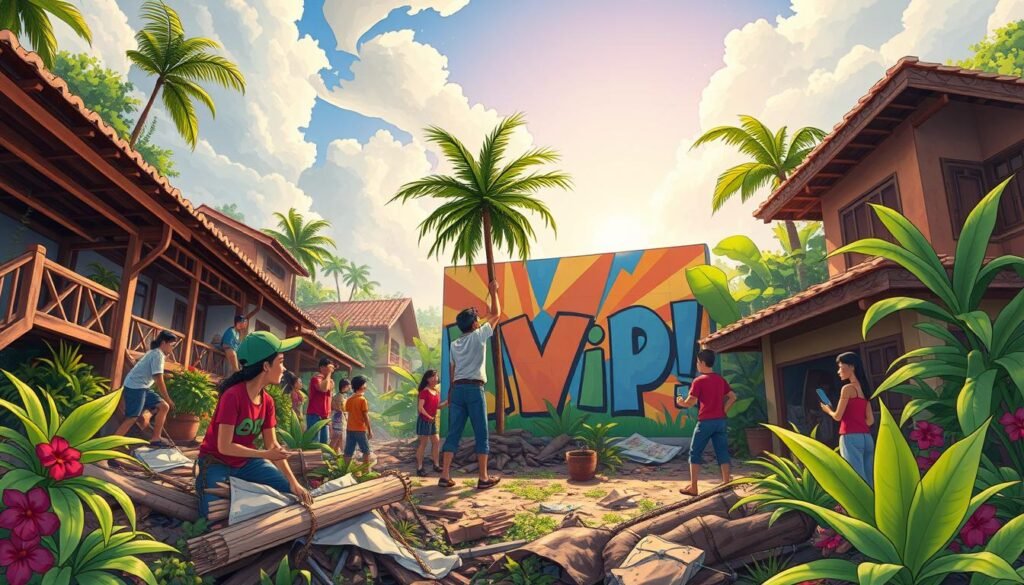
In conclusion, fighting natural disasters needs a broad approach. By using the strength and perseverance of Filipinos, we can lessen disaster impacts. This leads to a more resilient and sustainable future.
| Disaster | Year | Impact |
|---|---|---|
| Typhoon Haiyan | 2013 | Over 6,000 deaths and $2.8 billion in damages |
| Earthquake in Bohol | 2013 | Over 200 deaths and $50 million in damages |
| Floods in Metro Manila | 2012 | Over 100 deaths and $100 million in damages |
Economic Resilience Amidst Challenges
The Filipino people have shown great resilience in the face of economic challenges. They have hope for a brighter future and many have started their own businesses. Household spending has gone up, and money sent from abroad has helped families buy more.
The government has also helped a lot. For example, cutting down on rice import taxes has made food cheaper for many. Also, more people are working abroad, sending money back home.
Some key factors that help the Philippines stay strong economically include:
- Remittances from abroad, which continue to strengthen the purchasing power of Filipino families
- Government support and policies, such as reduced import tariffs on rice
- Overseas labor deployment, which has exceeded pre-pandemic numbers
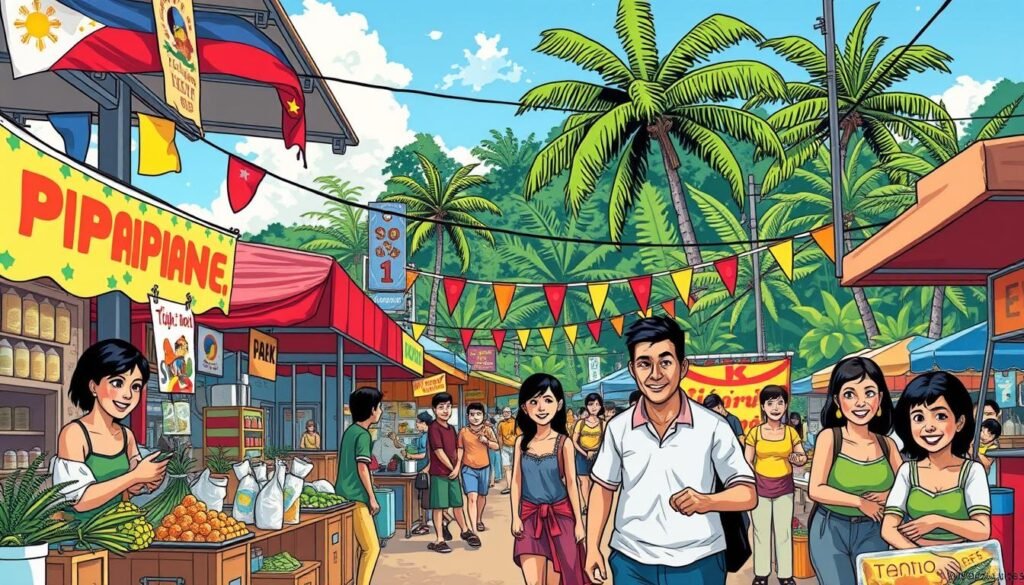
In tough times, the Filipino people have shown they can adapt and succeed. With hope for a better tomorrow, they keep working hard to build a stronger economy.
| Indicator | Pre-Pandemic | Current |
|---|---|---|
| Household Spending | Lower | Surpassed pre-pandemic levels |
| Remittances from Abroad | Lower | Continue to strengthen the purchasing power of Filipino families |
| Overseas Labor Deployment | Lower | Exceeded pre-pandemic numbers |
Resilience in Filipino Arts and Culture
Filipino arts and culture are key in showing and dealing with hard times. They help the nation stay strong and keep going. The rich cultural heritage, like literature, music, and art, often shows the people’s ability to bounce back.
Expression through Literature
Books and poems give Filipinos a way to share their stories and feelings. This helps build a sense of togetherness and support. It’s a way to find strength and keep going, even when things get tough.
Music and Visual Arts as Tools of Expression
Music and art are also important for sharing and dealing with hard times. After Typhoon Yolanda, people wanted music to find joy again. These arts help Filipinos stay strong and overcome obstacles.
Some notable examples of Filipino arts and culture include:
- Literary works, such as Noli Me Tangere and El Filibusterismo, which reflect the country’s history of resilience
- Traditional music and dance, such as the Tinikling and Cariñosa, which promote cultural heritage and community bonding
- Visual arts, such as paintings and sculptures, which express the Filipino experience and provide a platform for creative expression

Exploring resilience in Filipino arts and culture helps us understand the nation’s strength and perseverance. It inspires and empowers people to face challenges and build a stronger community.
| Art Form | Example | Expression of Resilience |
|---|---|---|
| Literature | Noli Me Tangere | Reflection of the country’s history of resilience |
| Music | Tinikling | Promotion of cultural heritage and community bonding |
| Visual Arts | Paintings and sculptures | Expression of the Filipino experience and creative expression |
The Role of Religion and Spirituality
Religion and spirituality are big parts of Filipino lives. They offer hope and strength when things get tough. A study found that spirituality is linked to better life satisfaction and health, even for those who faced hard times as kids.
In Filipino culture, faith is very important. Many people look to their beliefs for comfort and guidance when facing challenges. This is shown in the high number of Filipinos who go to church regularly and talk to spiritual leaders. Some key facts about spirituality in the Philippines are:
- Over 90% of Filipinos believe in a higher power
- 69% of Filipinos belong to a church or synagogue
- 82% of Filipinos acknowledge a need for spiritual growth
These numbers show how big of a role religion and spirituality play in Filipino lives. They give people a sense of hope and help them stay strong in tough times. As researchers say, spirituality is a lifelong journey that helps people find meaning, deal with loss, and connect with others.

In times of crisis, people often first turn to religious leaders for help. Faith and spiritual leaders are key in teaching about mental health and supporting their communities. By understanding the role of religion and spirituality, we can help people heal and recover better.
| Statistic | Percentage |
|---|---|
| Believe in a higher power | 90% |
| Belong to a church or synagogue | 69% |
| Acknowledge a need for spiritual growth | 82% |
Overcoming Mental Health Challenges
In the Philippines, about 52 million people face mental health or substance abuse issues each year. It’s key to build strength and perseverance to beat these challenges. Resilience training suggests that making connections, joining groups, and caring for your body can enhance resilience.
 Facing and overcoming childhood challenges without parental help also builds resilience. More social connections and close friendships help fight stress and anxiety, boosting resilience.
Facing and overcoming childhood challenges without parental help also builds resilience. More social connections and close friendships help fight stress and anxiety, boosting resilience.
Here are some ways to boost resilience skills:
- Building connections
- Joining groups
- Taking care of the body
- Practicing mindfulness
By working on these skills and adopting a healthy mindset, people can grow their strength and perseverance. The story of General Luciano San Miguel shows that resilience can develop with the right mindset and support over time.
| Strategy | Benefits |
|---|---|
| Building connections | Combats stress and anxiety |
| Joining groups | Aids in resilience against adversity |
| Taking care of the body | Boosts overall well-being |
The Importance of Youth Resilience
Helping young people build resilience is key for the country’s health. It lets them face and conquer tough times. By giving them hope and support, we help them grow strong and reach their dreams.
Studies show that youth resilience is vital for their well-being. Brain research points out that facing stress and failure helps them grow strong for adulthood. Important factors for youth resilience include:
- Positive guidance from caring adults
- Being active in schools and fun places
- Good friendships and social ties
- Getting to make choices and learn to control themselves
By supporting these areas, we help young people become resilient. Research shows that caring adults help a lot. Showing resilience boosts their confidence and helps them make smart choices. Investing in youth resilience means a brighter future for all, full of hope and chances to grow.

Resilience in Filipino Families
Family bonds are key in building resilience in Filipino families. These bonds give strength, helping family members get through tough times. A study in the Journal of Human Ecology and Sustainability shows that family resilience is about facing hard times and coming out stronger.
Family Bonds as a Source of Strength
A resilience-focused program in a post-disaster area shows how important family support is. The program had three parts: assessing needs, creating and implementing the intervention, and evaluating it. It included eight sessions on counseling, facing challenges, and setting goals.
Intergenerational Support Mechanisms
A study on Filipino family farmers during El Niño from 2008 to 2013 shows their resilience. Families tried to keep things stable and deal with the emotional and social effects of migration. They used strategies like diversifying crops and getting help from NGOs and LGUs.
- Diversifying crops
- Seeking assistance from NGOs and LGUs
- Engaging in different jobs
- Applying techniques from the International Rice Research Institute
- Gaining support from relatives

These strategies show the strength and perseverance of Filipino families. They highlight the role of intergenerational support in building resilience.
| Strategy | Description |
|---|---|
| Diversifying crops | Planting multiple crops to reduce dependence on a single crop |
| Seeking assistance | Receiving help from NGOs and LGUs to cope with migration |
| Engaging in different jobs | Taking on alternative employment to support the family |
Learning from Global Resilience Models
We need to look at global models to boost resilience in the Philippines. By studying their experiences, we can understand the challenges they face. This helps us find hope for a stronger future.
For example, the Near East Foundation has helped communities in tough spots. They’ve given entrepreneurs access to finance and helped land become more productive. They’ve also empowered women in different fields. These efforts show how important it is to use best practices to tackle local challenges and look forward to a brighter tomorrow.
Some key lessons from global resilience models are:
- Using sustainable agriculture to ensure food security
- Supporting inclusive and fair economic systems
- Working to solve environmental problems, social injustices, and resource issues to avoid conflict
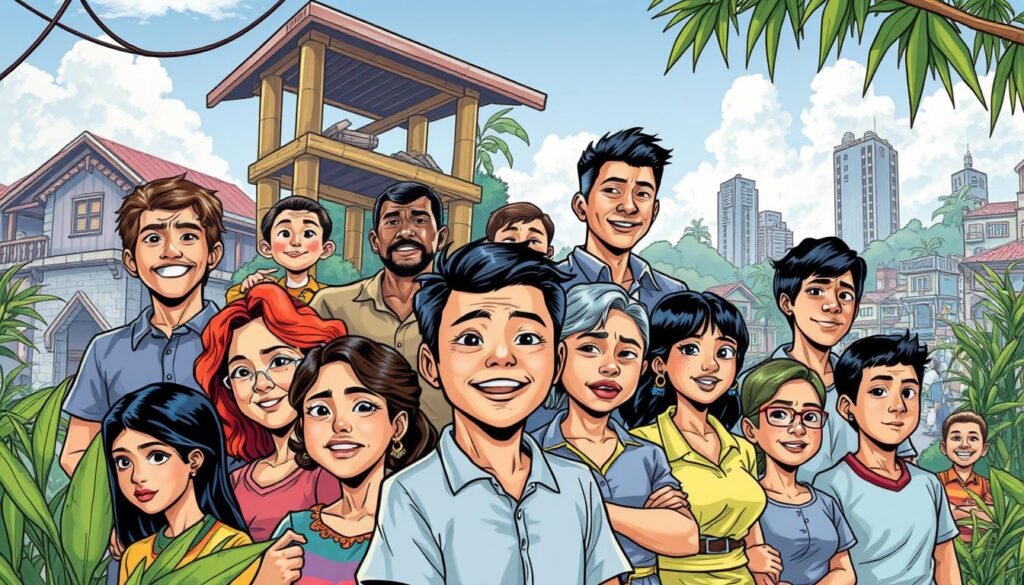
By adopting strategies from these global models, we can make the Philippines more resilient. We can face the challenges of the future with hope and determination.
| Organization | Initiative | Impact |
|---|---|---|
| Near East Foundation | Supporting entrepreneurs | 2,509 entrepreneurs supported |
| Mountain Harvest | Promoting regenerative agriculture | 1,042 smallholder coffee farmers empowered |
Future Implications of Filipino Resilience
Building a Resilient Nation
The Filipino people have shown great strength and perseverance in tough times. This is key for the nation’s future. As climate change and disasters hit, building a strong resilience culture is vital.
By focusing on disaster readiness, supporting key workers, and boosting mental health, the Philippines can grow stronger. This way, communities can not just get by, but flourish under any challenge.
Preparing for Future Challenges
The Philippines has a strong track record of overcoming crises. With 30 million young people, the country has a vibrant force for change. Programs like SHIELD show the way to a future where resilience is real for everyone.
FAQ
What is the cultural, historical, and psychological significance of resilience in the Filipino context?
Resilience is a big part of Filipino culture. It comes from the country’s history and the people’s mindset. Filipinos have shown great strength in facing challenges, from colonialism to natural disasters.
How does the Filipino community contribute to building and maintaining resilience?
The community plays a big role in building resilience. Social support and community efforts help Filipinos face challenges together. This collective strength is key to overcoming obstacles.
What are the key historical events and triumphs that have shaped the Filipino spirit of resilience?
The Philippines has faced many challenges, like colonialism and natural disasters. These experiences have made the nation resilient. They have shaped the Filipino spirit and ability to persevere.
How do personal stories of resilience inspire and empower the Filipino people?
Stories of resilience inspire many. They show the strength of both famous and ordinary Filipinos. These stories give hope and strengthen the community’s resilience.
What is the impact of education on developing resilience among Filipinos?
Education plays a big role in building resilience. Programs that teach perseverance help students face challenges. This has a big impact on the nation’s resilience.
How do Filipinos demonstrate resilience in the face of natural disasters?
Filipinos have learned to prepare for and respond to disasters. Their resilience after events like Typhoon Haiyan is impressive. It shows their collective strength and ability to recover.
What role do Filipino entrepreneurs and government policies play in fostering economic resilience?
Entrepreneurs and government policies are key to economic resilience. They help the country overcome economic challenges. This shows the nation’s ability to face adversity.
How do Filipino arts and culture serve as a reflection and expression of resilience?
Arts and culture reflect the nation’s resilience. Literature, music, and visual arts express and cope with adversity. They show the nation’s strength and perseverance.
What is the role of religion and spirituality in fostering resilience among Filipinos?
Faith is a source of strength for many Filipinos. Community support rooted in religion gives hope and comfort. This helps the nation’s resilience.
How are mental health challenges being addressed in the Philippines, and how does it impact the resilience of the people?
Mental health is being addressed by reducing stigma and supporting those affected. This empowers Filipinos to overcome mental health challenges. It builds a more resilient nation.
What is the significance of youth resilience in the Philippines, and how are young people being empowered to lead in crisis situations?
Empowering youth is important for the nation’s resilience. Young Filipinos are leading in crisis situations. Initiatives target the younger generation to build resilience.
How do Filipino families serve as a foundation for building and sustaining resilience?
Families are a source of strength and resilience. Their bonds and support mechanisms help the nation face challenges together. This is key to overcoming obstacles.
What can the Philippines learn from global resilience models, and how can it adapt best practices to enhance its own resilience?
Learning from global models can strengthen the Philippines’ resilience. Adapting best practices prepares the nation for future challenges. This is important for collective resilience.
Source Links
- The Filipino Resilience as a Form of Systemic Burden – https://girlpowertalk.com/filipino-resilience-as-a-form-of-systemic-burden/
- The Resilient Spirit of Filipinos: An Outsourcing Advantage in the Face of Adversity – https://www.linkedin.com/pulse/resilient-spirit-filipinos-outsourcing-advantage-face-adversity-czkqc
- PDF – https://www.researchpublish.com/upload/book/paperpdf-1593090736.pdf
- Measurement and antecedents of national resilience in Filipino adults during coronavirus crisis – https://pmc.ncbi.nlm.nih.gov/articles/PMC7461071/
- Frontiers | The Importance of Well-Being on Resiliency of Filipino Adults During the COVID-19 Enhanced Community Quarantine: A Necessary Condition Analysis – https://www.frontiersin.org/journals/psychology/articles/10.3389/fpsyg.2021.558930/full
- What is community resilience and why does it matter? | UrbanFootprint – https://urbanfootprint.com/community-resilience-meaning/
- “One community at a time”: promoting community resilience in the face of natural hazards and public health challenges – BMC Public Health – https://bmcpublichealth.biomedcentral.com/articles/10.1186/s12889-023-17458-x
- The Indomitable Spirit of the Philippines: How Resilience and Adaptability Shape the Filipino Workforce – https://www.yoonet.io/insights/the-indomitable-spirit-of-the-philippines-how-resilience-and-adaptability-shape-the-filipino-workforce
- What If There’s A Better Way To Talk About Filipino Resilience? – https://www.shopcambio.co/blogs/news/what-if-there-s-a-better-way-to-talk-about-filipino-resilience?srsltid=AfmBOopF-4vVPhQKrqC5s6JxV8RdQ_QOxRds15hEq89kRwKY0jou4vSz
- Typhoon Yolanda: A history of resilience – Xavier Network – https://xavier.network/news/typhoon-yolanda-a-history-of-resilience/
- Resilience Stories – Epic Work Epic Life – https://epicworkepiclife.com/resilience-stories/
- Al Siebert Resiliency Center » My Personal Resilience Story – https://resiliencycenter.com/my-personal-resilience-story/
- The impact of resilience on academic performance with a focus on mature learners – BMC Medical Education – https://bmcmededuc.biomedcentral.com/articles/10.1186/s12909-024-06099-2
- What is Academic Resilience? – Boingboing – https://www.boingboing.org.uk/defining-academic-resilience/
- An introduction to resilience in educational settings – THE EDUCATION HUB – https://theeducationhub.org.nz/an-introduction-to-resilience-in-educational-settings/
- Resilience – the key to overcome natural disasters – https://buildersproject.eu/blog/post/3/resilience-the-key-to-overcome-natural-disasters
- Resilience after natural disasters: the process of harnessing resources in communities differentially exposed to a flood – https://pmc.ncbi.nlm.nih.gov/articles/PMC8725694/
- Economic resiliency amid global challenges: the role of AI – https://www.linkedin.com/pulse/economic-resiliency-amid-global-challenges-role-ai-simone-di-somma-dq6pf
- PH economy resilient and set for growth amid challenges, says BDO analyst – https://mindanaotimes.com.ph/ph-economy-resilient-and-set-for-growth-amid-challenges-says-bdo-analyst/
- 2023—Global economic resilience amid persistent challenges – https://www.exportfinance.gov.au/resources/world-risk-developments/2023/december/2023-global-economic-resilience-amid-persistent-challenges/
- Filipino resilience: Family, faith and fun – https://www.philstar.com/lifestyle/arts-and-culture/2019/07/28/1938629/filipino-resilience-family-faith-and-fun
- Filipino Resilience and Why It Must Go – https://medium.com/vox-populi-ph/filipino-resilience-and-why-it-must-go-a00a5580c98b
- Spiritual resilience: Understanding the protection and promotion of well-being in the later life – https://pmc.ncbi.nlm.nih.gov/articles/PMC7743140/
- Frontiers | The associations between religiosity and resilience when individuals are challenged by risk factors of suicide and mental illness – https://www.frontiersin.org/journals/public-health/articles/10.3389/fpubh.2024.1442248/full
- Understanding the Role Religion and Spirituality Play on Mental Health – https://www.elcaminohealth.org/stay-healthy/blog/understanding-role-religion-and-spirituality-play-mental-health
- Resilience Is Key to Mitigating Mental Health Challenges – https://www.psychologytoday.com/intl/blog/becoming-resilient/202202/resilience-is-key-mitigating-mental-health-challenges
- Resilience and Mental Health – https://www.linkedin.com/pulse/resilience-mental-health-wellbeing-for-us
- 6 Ways to Develop Resilience for Better Mental Health – https://www.healthhub.sg/live-healthy/mentalhealth_resilience
- PDF – https://cssp.org/wp-content/uploads/2018/08/YT_Youth-Resilience.pdf
- PDF – https://cssp.org/wp-content/uploads/2019/01/Research-Briefs-and-Action-Sheets-YT-CW.pdf
- Resilience as a Positive Youth Development Construct: A Conceptual Review – https://pmc.ncbi.nlm.nih.gov/articles/PMC3353472/
- PDF – https://pap.ph/assets/files/journals/development-and-initial-evaluation-of-the-resiliencefocused-family-psychoeducation-rffp.pdf
- Family Resilience in the Context of Migration: Exploring the Lived Experience of Filipino Migrants’ School-Going Older Adolescent Children – Journal of Human Ecology and Sustainability – https://jhes.uplb.edu.ph/articles/202303/
- 086: RESILIENCE STRATEGIES OF FILIPINO FAMILY FARMERS: ENSURING FOOD AVAILABILITY DURING EL NIÑO PHENOMENON FROM 2008–2013 – https://bmjopen.bmj.com/content/5/Suppl_1/bmjopen-2015-forum2015abstracts.86
- Breaking barriers to development: Lessons from the Resilience for Peace and Stability, Food and Water Security Innovation Program – Global Resilience Partnership – https://www.globalresiliencepartnership.org/breaking-barriers-to-development-lessons-from-the-resilience-for-peace-and-stability-food-and-water-security-innovation-program/
- PDF – https://thescipub.com/pdf/ajessp.2023.87.106.pdf
- Resilience: A Model for Global Social Issues – https://link.springer.com/10.1007/978-3-030-68127-2_62-1
- Empowering Filipino Youth for a Resilient Future – https://www.undp.org/philippines/press-releases/empowering-filipino-youth-resilient-future
- Reclaiming the ‘Resilient Filipino’: From Romanticised Climate Narratives Towards Resilience-Focused Climate Policy in the Philippines | FULCRUM – https://fulcrum.sg/reclaiming-the-resilient-filipino-from-romanticised-climate-narratives-towards-resilience-focused-climate-policy-in-the-philippines/
- Rebuilding Differently for Resilience in the Philippines – https://www.undp.org/philippines/press-releases/rebuilding-differently-resilience-philippines

